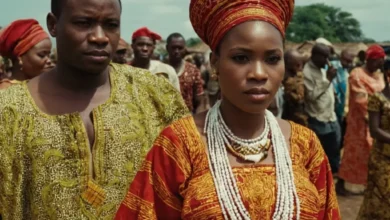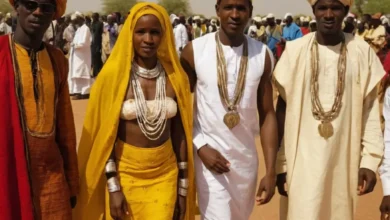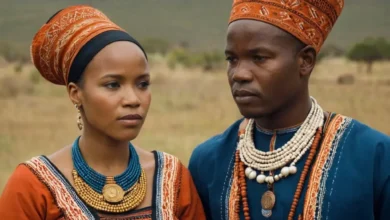Malian Traditional Clothing
Mali, a landlocked nation nestled in the heart of West Africa, is renowned not only for its captivating landscapes and vibrant culture, but also for its rich and diverse traditional clothing. From the intricate embroidery of the Dogon people to the vibrant colours of the Bambara, Malian fashion tells a compelling story of history, tradition, and artistic expression.
This article delves into the fascinating world of Malian traditional clothing, exploring the textiles, styles, and cultural significance that make it a captivating spectacle.
A Symphony of Textiles: The Heart of Malian Fashion
The foundation of Malian traditional clothing lies in its exceptional textiles. Woven with meticulous craftsmanship, these fabrics are not merely garments but testaments to the skills and creativity of the Malian people. The most prominent textile in Malian fashion is bògòlanfini, also known as mudcloth. This iconic fabric is hand-painted using a mixture of mud, fermented tree bark, and indigo dye.
The complex designs, often depicting geometric patterns and animal motifs, are created using a stenciling technique, adding a layer of depth and artistry to the fabric. Each piece of bògòlanfini is unique, reflecting the individual skills of the weaver and the cultural heritage it represents.
See also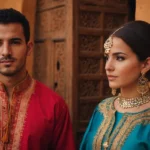 Moroccan Traditional Clothing: From Djellabas to Kaftans
Moroccan Traditional Clothing: From Djellabas to Kaftans
Beyond Mudcloth: A Tapestry of Textiles
While bògòlanfini holds a special place in Malian fashion, it is not the sole textile that contributes to the country’s diverse wardrobe. Other notable fabrics include:
- Bazin riche: A luxurious, handwoven cotton fabric from Côte d’Ivoire, known for its intricate patterns and vibrant colours. It’s a popular choice for special occasions and ceremonial wear.
- Kente: Originating from Ghana, kente is a handwoven silk and cotton fabric featuring intricate patterns and vibrant colours. It holds significant cultural meaning, representing the history, traditions, and social status of the wearer.
- Atlas: A silky, lustrous fabric imported from Morocco, atlas is commonly used for ceremonial garments and intricate embroidery.
These textiles are interwoven with Malian cultural identity, often reflecting the specific traditions and beliefs of different ethnic groups. The use of natural dyes, intricate weaving techniques, and symbolic patterns creates a rich tapestry of textiles that embodies the heritage and artistry of the Malian people.
A Spectrum of Styles: Reflecting Diversity and Identity
The diversity of Malian ethnic groups is reflected in the wide array of traditional clothing styles. Each style carries its own unique features, reflecting the cultural practices, beliefs, and social structures of the specific community.
The Dogon: Embracing Tradition and Innovation
The Dogon people, renowned for their unique cultural practices and architectural mastery, also boast a distinctive style of clothing. Kente, a garment made from bògòlanfini, is a staple of Dogon fashion. Men wear the kente as a long, flowing robe, often adorned with elaborate embroidery and tassels.
See also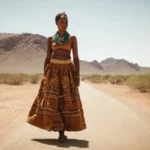 Namibian Traditional Clothing: Adapting to Desert Landscapes and Cultural Traditions
Namibian Traditional Clothing: Adapting to Desert Landscapes and Cultural Traditions
Women, on the other hand, wear a similar garment, the sanga, which is shorter and typically adorned with geometric patterns. The Dogon also utilize the tob, a sleeveless, flowing garment made from bògòlanfini, which is often worn over other garments.
What sets Dogon fashion apart is its embrace of tradition and innovation. While adhering to the core elements of their cultural attire, Dogon artisans constantly experiment with new designs, techniques, and colour combinations, injecting a modern touch into their traditional garments.
The Bambara: A Tapestry of Colour and Symbolism
The Bambara, known for their rich artistic heritage, showcase a vibrant and symbolic approach to clothing. Women’s attire often features buba, a loose-fitting, long-sleeved tunic, usually made from bògòlanfini, bazin riche, or atlas.
The buba is typically adorned with intricate embroidery, representing the wearer’s social status, marital status, and spiritual beliefs. Men, on the other hand, wear boubou, a long, flowing robe, often made from bògòlanfini or bazin riche. The boubou is frequently worn with a kufi, a traditional cap, adding a touch of elegance to their attire.
Bambara fashion is characterized by the use of vibrant colours, representing different aspects of their culture and beliefs. The colours symbolize everything from fertility and prosperity to spiritual power and social standing. This infusion of symbolism into clothing makes it a powerful form of visual communication, conveying a wealth of information about the wearer.
Beyond Ethnic Boundaries: A Shared Sense of Style
While each ethnic group in Mali possesses its own unique clothing style, there are certain elements that are shared across different communities. The boubou, for instance, is a ubiquitous garment worn by both men and women across various ethnic groups.
This shared element signifies a sense of unity and cultural connection, transcending ethnic boundaries. Additionally, the use of bògòlanfini and bazin riche as primary fabrics reinforces this sense of shared tradition and artistic expression.
More Than Just Clothing: The Cultural Significance of Malian Fashion
Malian traditional clothing is more than just attire; it’s a tapestry of cultural expression, reflecting the beliefs, values, and history of the Malian people. Each stitch, each pattern, each colour holds a deep and rich meaning, conveying a story that has been passed down through generations.
Symbolism and Storytelling
The intricate designs and patterns found on Malian clothing often represent stories, beliefs, and historical events. For instance, the geometric patterns on bògòlanfini often symbolize fertility, prosperity, and the interconnectedness of life. Animal motifs, such as the antelope, lion, and bird, represent different aspects of nature, strength, and spiritual beliefs.
Social Status and Identity
The type of fabric, style of garment, and embellishments used often reflect the wearer’s social status, age, and marital status. For instance, the use of bazin riche is often associated with wealth and prestige, while bògòlanfini, despite its rich history and cultural significance, is often associated with more traditional and rural communities. The intricate embroidery on garments often represents the wearer’s skills, artistic talent, and family lineage.
Rituals and Ceremonies
Malian traditional clothing plays a vital role in various rituals and ceremonies. Specific garments are worn for weddings, funerals, circumcision ceremonies, and religious festivals. These garments are often adorned with special colours, patterns, and embellishments, reflecting the significance of the occasion. For instance, brides may wear brightly coloured buba adorned with elaborate embroidery, while mourners may wear dark-coloured boubou as a sign of respect.
A Bridge to the Past
Malian traditional clothing serves as a tangible link to the past, connecting the present generation to their ancestors and the rich cultural heritage they inherited. By preserving and celebrating these traditional garments, the Malian people ensure that their unique cultural identity remains vibrant and alive for future generations.
The intricate weaving techniques, natural dyes, and symbolic patterns represent a testament to the enduring creativity and resilience of the Malian people.
The Evolution of Malian Fashion: A Blend of Tradition and Modernity
While Malian traditional clothing holds a cherished place in society, it’s not static. Over time, it has evolved to incorporate modern influences, creating a blend of tradition and modernity. The younger generation is embracing contemporary designs while preserving the essence of their cultural heritage.
This fusion is evident in the incorporation of modern fabrics, colours, and silhouettes into traditional garments, creating a dynamic and expressive style.
Malian Designers: Bridging the Gap
Malian designers are playing a crucial role in bridging the gap between tradition and modernity. They are reinterpreting traditional garments using contemporary techniques, materials, and designs, creating a fresh and innovative take on Malian fashion. These designers draw inspiration from their cultural heritage while incorporating modern trends, creating garments that are both stylish and culturally relevant.
The Global Stage: Celebrating Malian Fashion
Malian traditional clothing has garnered recognition on the global stage, with designers showcasing their creations at international fashion events. This exposure has helped to bring Malian fashion to a wider audience, celebrating the unique beauty and craftsmanship of the country’s textiles and styles.
The global recognition of Malian fashion has also contributed to the economic empowerment of artisans and designers, providing them with opportunities to showcase their talents and share their cultural heritage with the world.
FAQs
Where can I find Malian traditional clothing?
You can find Malian traditional clothing at various markets and shops in Mali. You can also find authentic Malian clothing at specialized boutiques and online retailers specializing in African fashion. It’s important to support ethical businesses that source their fabrics and garments responsibly and fairly.
What are the different ways to wear a boubou?
The boubou, a long, flowing robe, is a versatile garment that can be worn in many different ways. It can be worn as a dress, with a belt tied at the waist, or as a tunic over pants. The boubou is often adorned with embellishments, such as embroidery, beads, or tassels, adding a touch of elegance and personality to the garment.
How can I learn more about Malian fashion?
There are many resources available to learn more about Malian fashion. You can explore websites and blogs dedicated to African fashion, read books and articles on Malian culture and textiles, and attend fashion events and exhibitions showcasing Malian designers. Engaging with artisans and designers can also provide invaluable insights into the history, techniques, and cultural significance of Malian fashion.
Malian traditional clothing is a vibrant and expressive art form, a testament to the creativity and resilience of the Malian people. The intricate textiles, diverse styles, and deep cultural significance make it a captivating spectacle. By understanding the history, techniques, and symbolism behind these garments, we gain a deeper appreciation for the rich cultural heritage of Mali and the artistry of its people.
As Malian fashion continues to evolve, embracing modern influences while preserving its core traditions, it serves as a reminder that cultural expression is a dynamic process. It is a testament to the enduring power of tradition and the boundless creativity of the human spirit.

